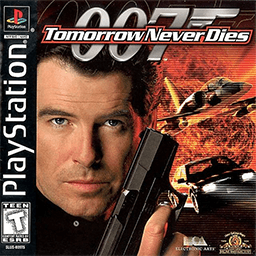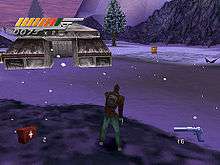Tomorrow Never Dies (video game)
| Tomorrow Never Dies | |
|---|---|
 | |
| Developer(s) | Black Ops Entertainment |
| Publisher(s) | Electronic Arts |
| Distributor(s) | MGM Interactive |
| Director(s) | William Botti |
| Producer(s) | John Botti |
| Designer(s) |
William Botti Daryl Kimoto Michael Guttentag Flint Dille |
| Programmer(s) |
An Nguyen William Botti |
| Artist(s) | Kris Kilayko |
| Writer(s) |
William Botti Flint Dille |
| Composer(s) | Tommy Tallarico Studios |
| Series | James Bond video games |
| Platform(s) | PlayStation |
| Release date(s) | |
| Genre(s) | Third-person shooter, stealth |
| Mode(s) | Single-player |
Tomorrow Never Dies (also known as 007: Tomorrow Never Dies) is a third-person shooter stealth video game based on the James Bond film of the same name. Developed by Black Ops Entertainment and published by Electronic Arts, it was released exclusively for the Sony PlayStation in November 1999. It is the first 007 game of many that was published by Electronic Arts since acquiring the James Bond licence. This game marks the second appearance of Pierce Brosnan's James Bond, although the voice of Bond is provided by actor Adam Blackwood in the game.
Plot

Bond begins to cross the Russian border from China into a Russian radar base, which is intercepting messages delicate in subject. Using a laser designator, Bond targets the dish and a British jet flies over, dropping an Air to Surface missile. A helicopter arrives, and Bond kills the occupants, and recovers a key. He uses the key to unlock a large gate, and makes his escape on skis. Bond reaches the end of the run - a sheer cliff drop. Bond continues on, and opens his Union Jack parachute, reminiscent of that from The Spy Who Loved Me.
Bond later lands in an Arms Bazaar. After taking photographs of military hardware, a British naval ship launches a BGM-109 Tomahawk to eliminate all potential threats and hardware. Bond realizes there are nuclear weapons at the Bazaar on a MIG jet (in reality, the jet was a L-39 Albatros). After an intense firefight between Bond and Russian terrorists, he hijacks the jet and returns to MI6.
Bond is sent to investigate a man called Elliot Carver during a party in Hamburg, Germany after a British warship sank in the South China Sea, with all hands going down. Carver media published the full story before MI6 received a full report, raising MI6's suspicions. During the party Bond meets his former lover, Paris, now Carver's wife, who slaps him. Carver arrives, and offers a "tour of the facilities". Bond follows, but is knocked out by a henchman. He wakes up in a room with a large 2-way mirror. He uses his laser-cufflinks to escape, then he destroys the central computer, allowing him to make his escape. He then makes his way to the press, and engages in a firefight between Carver's guards.
He recovers Henry Gupta's GPS scrambler, which was used to lure the British Navy into Chinese waters to try and spark an international incident. As the existing Chinese government is not receptive to giving Carver Media Group Network exclusive broadcast rights in China, Carver plans to start a war to eliminate the present government and replace it with politicians more supportive to his plans. Bond then escapes to the "Hotel Atlantic", where Paris is being held prisoner. He arrives, and heads to the bar where he asks to see Paris; resulting in a shootout between Bond and the guards, who were working for Carver. Bond uses the elevator to get to Paris' apartment, where he meets Kaufman. Kaufman tries to kill Bond by using spinning razor discs and an AK-47. Bond kills Kaufman and helps Paris escape. They make it to the underground garage, where Bond drives away in his BMW 7 Series.
MI6 has found the headquarters of Henry Gupta near the foothills of the Swiss Alps. The convoy of terrorist cars and trucks is heading to Henry's alpine hideout for an important meeting. Bond is sent to stop the convoy. Along the way Bond meets Q, who gives him the BMW to stop the Convoy. Bond successfully destroys the convoy with the BMW and drives away. Bond is then sent to a ski ridge in Hokkaido, Japan, to track down and kill chemical expert Sotoshi Isagura, who is thought to be working for Elliot Carver after a nerve gas attack at Yokohama. The Carver Media was also the first to report the story. Bond kills Isagura and is sent to Saigon.
Bond steals a data disk from Carver Media Tower in Saigon but is captured. Bond manages to escape with the data disk. The next night, Carver bribes the Saigon Military Police to kill Bond on sight, so MI6 pulls Bond out as the mission would be compromised were Bond to be seen or killed. Bond gives Wai Lin the data disk, and Wai Lin engages the Saigon Military Police in a gun battle with the Police setting roadblocks and using fast firing chain guns. She makes it back to her lab to find the location of Carter's stealth boat. On the stealth boat, Bond uses the boat's comm-link to give MI6 its position. Wai Lin is kidnapped but is later freed by Bond after he kills Carver's right-hand man, Stamper. Wai Lin stops the engine while Bond shoots and kills Carver and stops the stolen nuclear missile from destroying Beijing. Bond and Wai Lin escapes the stealth boat before it self-destructs.
Gameplay
Tomorrow Never Dies broke away from the gameplay that made GoldenEye 007 a success, by choosing to make a third-person shooter and by leaving out a multiplayer portion of the game. It is the first of three games in the James Bond franchise that allows players to control a character other than James Bond himself, namely Wai-Lin in one level.
Development
The game was originally intended as a continuation of the film with a story that would have picked up where the film left off.[1] David Bishop, president of MGM Home Entertainment, said in June 1998, "We didn't see any benefit to following the script verbatim. We just felt we had more freedom in what we could bring the gaming world if we went outside the set script."[2] However, focus groups were more interested in seeing familiar scenes from the film.[1] Additional levels and a two-player mode were removed from the game during development.[3]
Reception
| Reception | ||||||||||||||||||||||||||||||||
|---|---|---|---|---|---|---|---|---|---|---|---|---|---|---|---|---|---|---|---|---|---|---|---|---|---|---|---|---|---|---|---|---|
| ||||||||||||||||||||||||||||||||
Tomorrow Never Dies was met with very mixed reviews. It received an average score of 62.44% at GameRankings, based on an aggregate of 28 reviews.[4] It was criticized for its changes from a first-person to third-person shooter, the average gameplay, awkward controls, short length and lack of a multiplayer component. As a result, it did not capture the same success as its predecessor GoldenEye. However, the voice acting and soundtrack were praised, and for the most part, the game stayed true to the film's source material. It was not until 2004 that another third-person shooter based on the Bond franchise, Everything or Nothing, would emerge.
See also
References
- 1 2 Perry, Douglass (1999-05-11). "Pre-E3: Tomorrow Never Dies Interview". IGN. Retrieved 2015-01-05.
- ↑ Ragals, Dave (1998-06-11). "Lights, Camera, Interaction!". CNN. Archived from the original on 2003-10-20.
- ↑ Perry, Douglass (1999-10-29). "Tomorrow Never Dies". IGN. Retrieved 2015-01-05.
- 1 2 "007: Tomorrow Never Dies for PlayStation". GameRankings. Retrieved 2012-08-20.
- ↑ Marriott, Scott Alan. "Tomorrow Never Dies - Review". AllGame. Archived from the original on 2014-12-07. Retrieved 2014-12-07.
- ↑ Edge staff (January 2000). "Tomorrow Never Dies". Edge (80).
- ↑ "Tomorrow Never Dies". Electronic Gaming Monthly. 2000.
- ↑ Mears, Rick (1999-12-02). "REVIEW for Tomorrow Never Dies". GameFan. Archived from the original on 2000-06-11. Retrieved 2014-03-19.
- ↑ "Tomorrow Never Dies - PlayStation". Game Informer. January 24, 2000. Archived from the original on 2000-12-05. Retrieved 2013-12-12.
- ↑ Uncle Dust (1999-11-20). "Tomorrow Never Dies Review for PlayStation from GamePro.com". GamePro. Archived from the original on 2005-02-15. Retrieved 2013-12-12.
- ↑ Liu, Johnny (December 1999). "Tomorrow Never Dies Review". Game Revolution. Retrieved 2013-12-12.
- ↑ Fielder, Joe (1999-11-22). "Tomorrow Never Dies Review". GameSpot. Retrieved 2013-12-12.
- ↑ Perry, Doug (1999-11-19). "Tomorrow Never Dies". IGN. Retrieved 2013-12-12.
- ↑ "Tomorrow Never Dies". Official U.S. PlayStation Magazine. December 8, 1999.
- ↑ Braxton-Brown, Justin (2000-01-14). "Frustration never dies in Bond's 'Tomorrow'". The Cincinnati Enquirer. Archived from the original on 2006-03-16. Retrieved 2013-12-12.